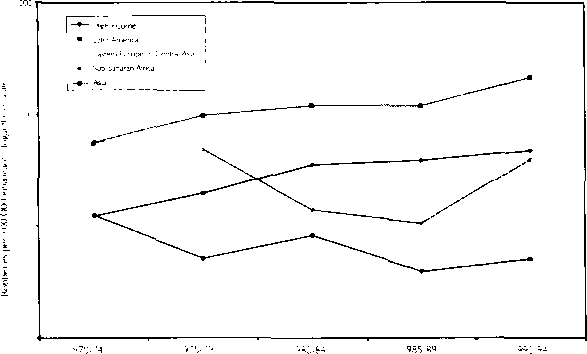Desarrollg y s
Seftiemme de 1999

from 6.5/hti to 10∕hti6. Criminalityis roughly 30 per cent Iowerin Europe.
The UK is probably at the lower end of the range for big countries with a
robbery rate around 60/hti and a homicide rate below 2/hti for the 1970-
1994 period. It may be seen in Figure la and Ib that these roughly
correspond to median rates of the whole group of high-income countries.
However, it must be kept in mind that all the preceding figures are national
averages. Criminality would be higher if only major metropolitan areas
were considered. For instance, the homicide rate in New York City is
approximately twofold the national average, i.e., 20/hti vs. 10∕hti.
Figure 1α. Evolution of Robbery Rates: Regional Median,
1970-1994

The most salient feature of Figure 1 when looking at other regions is
without any doubt the extremely high level of criminality in Latin American
and Caribbean (lac) countries. The difference with the other regions of
the world is striking. The (reported) robbery rate is almost uniformly
comparable among I-AC countries to what it is in the USt i.e., around 200/
hti, and often higher, even in countries one would have considered as
rather peaceful or not very violent in view∙ of their relatively developed
sv7stem of social services -e.g., Costa Rica or Uruguay-. The same is true
f‘ The notation hti in what follows indicates crime rates expressed per 100.000 inhabitants.
67
More intriguing information
1. The name is absent2. Are Japanese bureaucrats politically stronger than farmers?: The political economy of Japan's rice set-aside program
3. Delayed Manifestation of T ransurethral Syndrome as a Complication of T ransurethral Prostatic Resection
4. Bird’s Eye View to Indonesian Mass Conflict Revisiting the Fact of Self-Organized Criticality
5. Education Research Gender, Education and Development - A Partially Annotated and Selective Bibliography
6. A Dynamic Model of Conflict and Cooperation
7. Parent child interaction in Nigerian families: conversation analysis, context and culture
8. The name is absent
9. The name is absent
10. Do the Largest Firms Grow the Fastest? The Case of U.S. Dairies